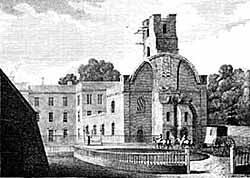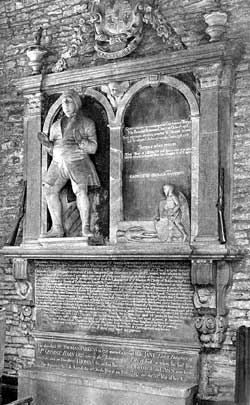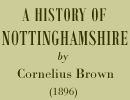< Previous | Contents | Next >
Bunny
 Bunny Hall in the late 18th century (Throsby,
1790).
Bunny Hall in the late 18th century (Throsby,
1790).The next village is Bunny, and in the midst of it is the Hall, with its beautiful grounds, while on the opposite side of the road stand the imposing parish church and schools. At an early period in its history Bunny was the property of the family of Fretcheville, who afterwards became resident at their manor at Staveley, and at a later date the tenants of Bunny had as their landlord no less a personage than the famous Ralph, Lord Cromwell, the Lord High Treasurer to Henry VI. After Lord Cromwell’s time, the manor was owned by the Illingworths, and from them it passed by the marriage of the three daughters and heiresses of Richard Illingworth to George Barlow, John Kniveton, and John Dethick. Eventually the whole estate came,into the possession of Humphrey Barlow, whose monument, consisting of a fine tablet bearing his coat-of-arms, is in the south aisle of the church.
The inscription is now obliterated, but we learn from Thoroton that he died on July 10, 1571, and his widow married Richard Parkyns and conveyed the property to him. This worthy was Recorder of Leicester and Nottingham, and his eldest son, George, received the honour of knighthood. His son Isham, who is commemorated by a slab in the chancel, was Colonel and Governor of Ashby-de-la-Zouch in ye Civil Wars against ye rebels in King Charles ye First’s time.’ Thomas, the second son of Isham, succeeded to the estates, the eldest son having died before his parents; and his son, also a Sir Thomas, was famous as the most enthusiastic athlete and wrestler of his time. After being educated at Westminster and Cambridge, he took up his residence at Bunny, and taught wrestling gratuitously to some of his friends amongst the nobility and gentry, establishing an annual wrestling-match in his park, the prize for which was a gold-laced hat value twenty-two shillings, and three shillings for the second best.

Monument to Sir Thomas Parkyns in Bunny church.
The Baronet published a book, entitled ‘The Inn Play, or the Cornish Hugg Wrestler,’ giving full directions how to ‘break all holds, and throw most falls mathematically.’ The third edition, published in 1727, was ‘sold by Humph. Wainwright at Bunny, in Nottinghamshire,’ and a very quaint and curious little volume it is. Wrestling and classics were to Sir Thomas the constant joy of his life, and while he sedulously promoted tlie one, he was proud of his acquaintance with the other. He distributed Latin quotations throughout his book, and had them inscribed freely upon buildings in the village. Some time before his death the eccentric Baronet caused his own monument to be carved and to be placed opposite his pew in the chancel, that he might look upon it every Lord’s Day and say, ‘What is life?’ He made a collection of stone coffins, and when death gave him the back-fall, which it did in his seventy - eighth year, he was buried in one of them in 1741. His remains lie in the vault at the east end of Bunny Church, and on the north wall is his monument, representing him, life size, in wrestling- dress, potent and postured, ready for either flying horse or Cornish hugg.
His attitude is the first position in wrestling, and on either side of him are the words ‘Artificis status ipse fuit.’ On the other half of the monument is the wrestler stretched on the floor, having been cut down by Time, and the words:
‘That Time at length did throw him, it is plain,
Who lived in hope that he should rise again.’
There are also the words ‘Tempus edax rerum,’ a Greek quotation, and some Latin verses, which may be rendered thus:
‘Here lies, O Time, the victim of thy hand,
The noblest wrestler in the British strand;
His nervous arm each bold opposer quelled
In fields of strength, by none but thee excelled,
Till, springing up at the last trumpet-call,
He conquers thee, who wilt have conquered all’
The monument is stated by Throsby to have been ‘wrought out of a fine piece of marble by his chaplain in a barn.’
Among the other notabilities buried at Bunny, mention may be made of Thomas Boothby Parkyns, first Baron Rancliffe in the Irish peerage, who died on November 17, 1800, and to whom there is a mural monument. He was succeeded by his son, who at one time represented Minehead and Nottingham in Parliament, but retired from public life in 1830, and died November 1, 1853, when the peerage became extinct.
